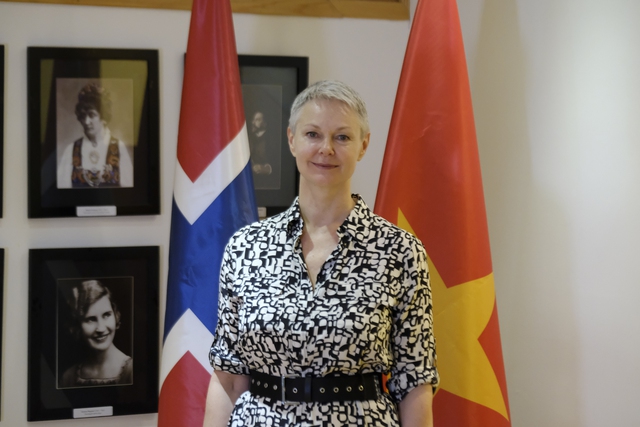Advancing circular waste solutions and potential of co-processing in Viet Nam
VGP - UNDP Resident Representative in Viet Nam Ramla Khalidi and Norwegian Ambassador to Viet Nam Hilde Solbakken have released an Op-Ed on advancing circular waste solutions and potential of co-processing in Viet Nam.

UNDP Resident Representative in Viet Nam Ramla Khalidi
New solutions for urgent challenges
As nations worldwide tackle the twin challenges of climate change and plastic pollution, new and proven solutions are needed. Co-processing is one such solution, increasingly recognized as a useful tool in the transition to a circular economy.
This technology uses non-recyclable waste as a substitute for fossil fuels and raw materials in energy-intensive industries such as cement production. Co-processing can help manage non-recyclable waste, reduce reliance on fossil fuels, and cut emissions.
For developing countries with growing waste streams, like Viet Nam, it represents an immediate and practical lever for change, provided it is implemented as part of a holistic approach that prioritizes waste reduction, reuse, and recycling and is supported by robust regulations and careful, regular monitoring.
A win-win-win solution
The benefits of co-processing can be identified across environmental, economic and climate fronts:
Environment: Co-processing safely disposes of non-recyclable waste in cement kilns, where extreme temperatures (over 1,450°C) can ensure the complete destruction of pollutants. Unlike Waste-to-Energy (WtE), it produces no residual ash, as waste components are integrated into the final cement product.
Economics: It can be a cost-effective solution for both industry and municipalities. Companies save money by replacing expensive coal with waste, while municipalities can use existing cement plants and avoid the high capital costs of building new waste treatment facilities.
Climate: By replacing fossil fuels, co-processing reduces greenhouse gas (GHG) emissions. In Europe (including Norway), where the practice is widespread, up to 75 percent of the traditional fuel used in cement production is replaced with waste.
In India, co-processing has been scaled across multiple cement plants, with proven reductions in fossil fuel use, greenhouse gas emissions, and landfill dependency.
Scientific confidence and global experience
The science backs this up. Partners such as SINTEF, one of Europe's largest research institutes, have demonstrated that cement kilns can safely and completely destroy organic pollutants. Dr. Kåre Helge Karstensen, Chief Scientist at SINTEF and leader of the OPTOCE project (Ocean Plastic Turned into Circular Economy) notes:
«Viet Nam is investing in WtE plants (1,400 MW planned), but co-processing in cement kilns offers a faster, cheaper option to cut coal use, curb leakage, and support circular economy goals. This method avoids the environmental risks associated with incineration, and when properly managed, does not produce toxic ash or emissions".
But safeguards are essential, and successful deployment of co-processing is only possible when supported by:
Robust regulatory frameworks and strict operational controls which are critical to ensure facilities operate safely and that the high-temperature incineration process fully destroys pollutants;
Real-time monitoring and independent verification of emissions to ensure compliance with national environmental standards, which in turn builds public trust and mitigates potential health risks.

Norwegian Ambassador to Viet Nam Hilde Solbakken
Not a silver bullet, but a key piece of the puzzle
Like WtE, co-processing is not a stand-alone solution. It must be part of a broader circular economy strategy that prioritizes prevention, reuse and recycling.
Co-processing is most effective for residual, non-recyclable waste ensuring that valuable resources are not lost, in line with the waste hierarchy, which prioritizes reducing waste at source through eco-design, reuse, and scaling up recycling.
Viet Nam generates nearly 4 million tons of plastic waste annually, much of which is non-recyclable with a high chance of ending up in landfills or the ocean. For provinces like Quang Ninh, which is developing its WtE capacity, the opportunity lies in adopting a mix of complementary solutions to address different waste streams.
With several cement plants already in operation in the province, co-processing could be a practical and complementary solution to the province's waste-to-energy plans, offering a faster and more cost-effective way to reduce reliance on landfills and cut emissions.
A local model for a national shift
Our collaboration in Quang Ninh has shown this potential first hand. For years, UNDP and the Embassy of Norway have worked with the province on waste collection and sorting, including supporting informal waste workers and piloting co-processing in the Lam Thach Cement Plant. This experience shows that technical solutions can be successfully embedded in inclusive, community-based approaches.
Quang Ninh's leadership has a clear vision for waste management and reducing greenhouse gas emissions. Co-processing in the cement industry could give them one more tool to reach these goals sooner and at lower cost.
With the backing of UNDP, Norway, and other partners, Quang Ninh could become a national model for circular waste management, one that integrates innovation, environmental protection, and economic efficiency.
Looking ahead
Co-processing is not a silver bullet. But as part of a broader waste management and circular economy strategy, it can play a vital complementary role. Combined with WtE, scaling up recycling, and reducing waste at source, it offers Viet Nam a faster and more affordable way to turn residual waste into a resource.
We look forward to continued dialogue and collaboration, and to supporting Viet Nam in its journey toward a cleaner, greener future./.
